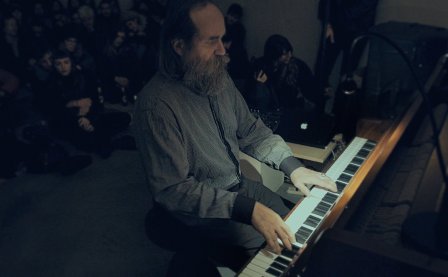Lubomyr Melnyk’s music was born of hunger — not dramatic, existential hunger, but actual, physical starvation. At the time, in the 1970s, Melnyk was a young Ukrainian-Canadian musician living in Paris, a budding pianist and an admirer of Terry Riley and John McLaughlin. Often, he says, he went days without eating, was destitute, lived in the streets sometimes. At one point, though, he found work as a janitor at the Paris Opera, which is where he met dancer Carolyn Carlson. Carlson had heard of Melnyk’s piano playing and asked him to score a piece she was choreographing. In his state of perpetual near-starvation, he sat down at the piano and found the music, the way one digs into the dry ground and, somehow, finds damp dirt underneath.
Forty years later, with the release of Rivers and Streams, Melnyk’s music is still born of principally physical needs. He builds chords into thunderheads, issuing patterns of notes that expand outward while he rides the sustain pedal, creating what he calls “continuous music.” Melnyk boasts that he’s capable of striking 19.5 notes per second, and to see him perform is mainly to watch in awe as he approaches this. As it was when he composed for Carolyn Carlson, the music is primarily about Melnyk’s own body, his own hands and how they touch the keys.
Interviewers are often drawn toward Melnyk’s hands; one, noticing that they were swollen and twisted, asked him how he looks after them. “I don’t, there’s nothing to look after,” he replied. “They don’t exist.” When he plays, his hands are absorbed into the piano. Time disappears. His playing is pacifying, both for him and for the listener, like looking at a starry sky, the notes arrayed in front of you and laying on top of you, twinkling at their own intervals. Born of Melnyk’s starvation, it’s about filling one’s self up with notes.
Rivers and Streams is Melnyk’s seventh release since he emerged in 2007, after Unseen Worlds reissued his 1979 piece KMH, composed during his days scavenging in Paris. Between 1979 and 2007, Melnyk was resolutely, brutally unknown, receiving mixed reviews when he received them at all and laboring, frustratedly, in silence. Listening to Rivers and Streams, it doesn’t seem much time has passed at all (though it’s even prettier than much of Melnyk’s early work, free of the early pieces’ occasional dissonances). Pieces like “Parasol” and “Sunshimmers” bear the semblance of melody but are at their core just circular swaths of notes gently warped ad infinitum. Like all of Melnyk’s work, they are suites about becoming absorbed in the body, about his own efforts to maintain footing against the flow of time.
But if Melnyk’s technique hasn’t changed, he is breaking new conceptual ground. “The Pool of Memories” emulates the surface of a pool, high and midrange notes striking and radiating outward; then, after a few minutes, the notes splash lower, becoming more turbulent before gradually floating back up to the surface. It’s an observation about the nature of memories — how they exist next to each other in the mind, out of order and out time, and the way they don’t replay as narratives but as emotional topography.
Flowing bodies of water, though, are the album’s dominant metaphor for the passage of time — a tired or timeless metaphor, depending on your perspective. Rivers and streams always move forward but also exist distinctly at any point on their course, the way the Amazon of the highlands and the Amazon of the lowlands (the subjects of the final two pieces on the album) are one river but two distinct entities. “The Amazon: The Highlands,” the album’s penultimate piece, is like the chart of flow of time as it is maneuvered by a solitary being; the flow is all Melnyk, but the body is gorgeously represented by Hyelim Kim, who accompanies him on the taegum, a throaty Korean flute whose sound is a cross between a human cry and the call of a tropical bird. As the taegum skims the surface of Melnyk’s churning figure, it serves to remind us that the physical body, its hunger and its withered fingers, is a raft on which we float ever on down the river, balancing between inner stasis — be it peace or suffering — and continuous forward movement.
More about: Lubomyr Melnyk




